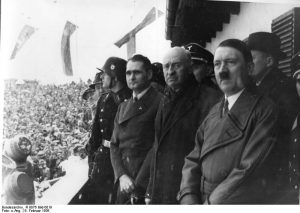 The modern Olympic games were started by Frenchman Henri de Baillot-Latour to promote international understanding. The first games of the modern era were held in 1896 in Athens, Greece. Australia has competed in all the Olympic games of the modern era, although our participation in the first one was almost by chance. Of course, the Olympics predated Federation by 5 years, so there was officially no “Australia” as a unified country – rather a collection of separate colonies of Britain. In fact, OpenSTEM®‘s Understanding Our World® program offers National Sport as a optional topic for students in Year 6, for studying Federation and the development of a national identity.
The modern Olympic games were started by Frenchman Henri de Baillot-Latour to promote international understanding. The first games of the modern era were held in 1896 in Athens, Greece. Australia has competed in all the Olympic games of the modern era, although our participation in the first one was almost by chance. Of course, the Olympics predated Federation by 5 years, so there was officially no “Australia” as a unified country – rather a collection of separate colonies of Britain. In fact, OpenSTEM®‘s Understanding Our World® program offers National Sport as a optional topic for students in Year 6, for studying Federation and the development of a national identity.

An Australian, Edwin Flack, born in London and moved to Victoria at the age of 5, later attending Melbourne Church of England Grammar School, was a keen runner, taking part in amateur athletics with the Melburnian Hare and Hounds Athletics Club. Flack went overseas to work in London and New York as an accountant, at the age of 21, and decided to attend the inaugural Olympic games as a spectator. He spent 6 days travelling by rail and sea, and was dreadfully sea-sick, before arriving in Athens. However, once there, he decided to take part in the games and won his first race on the opening day – an 800m heat, which he completed in 2 min 10 sec. On the second day he beat the American favourite in the 1500m race and then won the 800m final on the fourth day. Flack competed in the colours of his high school in Melbourne, there being no official national colours or uniform for Australia yet. He is credited with 2 gold medals and a bronze medal for doubles tennis, although it was not until 1904 that medals were actually awarded at the games. Flack later joined the Australian Olympic Committee and represented Australia at the International Olympic Committee Congress. Flack’s medals have been credited to Australia by the international Olympic committee, which means that Australia is ranked as a country that has taken part in every modern Olympics.

Winter Olympics did not begin until 1924 and Australia did not compete in the Winter Olympics until 1936, although they have participated in every one since, with the exception of the games of 1948. In 1936 the games were held in the market town of Garmisch-Partenkirchen in Bavaria, Germany. A picture taken at the opening ceremony shows a rather concerned looking Henri de Baillot-Latour standing between Rudolf Hess and Adolf Hitler. History may have justified Baillot-Latour’s expression… Australia was represented by Kenneth Kennedy, who took part in the speed skating event, coming 33rd in both the 1500 and 5000m events and 29th in the 500m event. Not being a country renowned for its winter sports, and having a climate not particularly conducive to supporting the training of local athletes, it was many years before Australia was a serious contender in any of the winter sports. It was not until 1994 that Australia won its first medal at the Winter Olympics – a bronze in the short track relay.
However, modern technology which increased access to training options for athletes and increased support for the winter sports by the Australian Olympic Committee have seen Australia forge ahead in recent decades. In 2002 Australia won its first 2 gold medals (the first time any country from the southern hemisphere had won a winter Olympics event) for short track speed skating (which Steven Bradbury won after all the other competitors crashed out) and aerials.

2010 was Australia’s most successful Winter Olympics. The games were held in Vancouver, Canada and Australia won 2 gold and 1 silver, with a further 7 athletes finishing in the top 10 in their events. Torah Bright, who was the Australian flagbearer, won a gold medal for the snowboard half-pipe. Lydia Lassila took gold in the aerial skiing. Dale Begg-Smith took silver in the men’s mogul skiing.
This year Australia has 51 athletes competing in 10 sports in PyeongChang in South Korea. Matt Graham has already taken a silver medal in men’s moguls and Scott James has taken a bronze in men’s snowboard half-pipe, with many events still to be completed. Go Aussies!
Current events such as the Winter Olympics can be a great vehicle for teachers to achieve student engagement. There are heaps of ways that these events can be incorporated into students’ learning – from looking at how they can hold the Winter Olympics while we’re sweltering through the tail-end of summer (our Torch and Ball activity demonstrates global seasons as well as day and night, specifically aimed at Science for Years 1 to 3 , it can be a great thing to revise in higher years too); to the Geography and climate of the different venues around the world; from the historical events surrounding many Olympics to the development of an Australian national identity, and national sport, around Federation. The broad range of OpenSTEM® resources are aimed at helping teachers to guide the interests of the students towards the outcomes of the curriculum, whilst keeping the process interesting and engaging.

My grade 4 son's review is below. I think he liked seeing the patterns it made. It was just a…
Brad